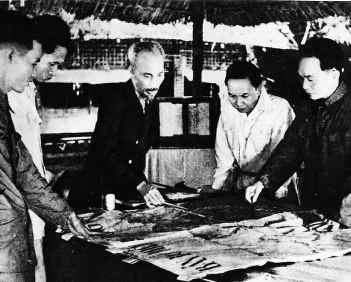France (location: Indochina) 1954

Ho Chi Minh (center) and Vo Nguyen Giap (right) plan the battle of Dien Bien Phu
As we saw elsewhere on this site, for several years, Washington provided extensive emergency military aid to France in its fight against the Vietminh. By 1954, however, the French were in grave difficulty, with their fortress of Dien Bien Phu being besieged. The possibility of the U.S. entering into combat along with France was repeatedly discussed but each time ran up against the problem that the Vietnam was not truly an independent state, that the French were not disposed to grant it independence and still keep fighting, and that the U.S. would therefore be acting not as a client state's patron but as a colonizer. Instead, the United States accepted French defeat in the northern part of Vietnam and agreed not to “disturb” the arrangement worked out at the Geneva conference in July: Vietnam was to be temporarily divided along the 17 th parallel. Immediately, the U.S. began to build up the state of South Vietnam , giving it extensive aid and, in effect, blocking the elections that were to reunify the country two years later. 1
1) Declaration by Smith on behalf of the U.S. , 21 July 1954, FRUS 1952-1954 , vol. 13, pt. 2: 1860; also 1733, 1734, 1748, 1752, 1754, 1758, 1774, 1791, 1828-9 (all on acceptance of partition); Gibbons (1986: chs. 3-5). Even if one accepts the argument that the U.S. never intended to use its own troops in 1954 (Porter 2005: ch. 3), the arguments against combat forces and the conditions attached to the offer of such forces both hinged on granting genuine independence to the Indochinese states.
